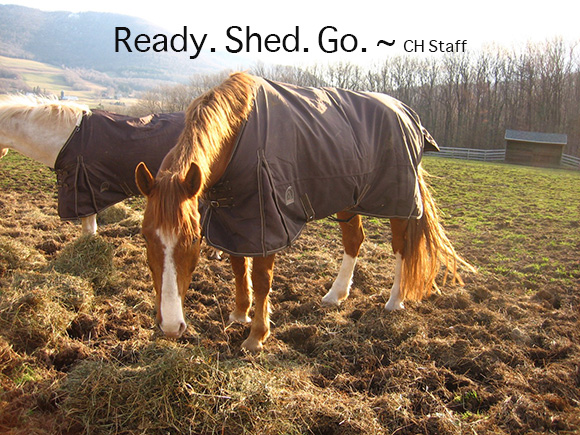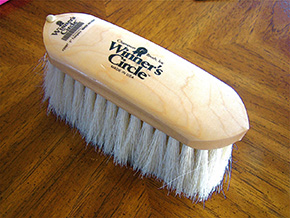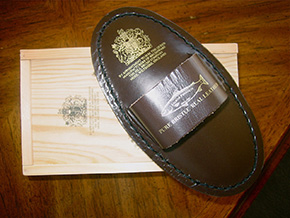Ready. Shed. Go. ~ CH Staff

Get ready! Spring is coming. The Merry Band at the Catskill Horse is optimistic that after all the brutal weather on the East Coast the next season will come in like a lamb. It will truly be here before you know it and now is a great time to organize your tack trunk and grooming kit and be prepared for the warmer weather. If you are living in the North East and have not been competing down South or working your horse on a daily basis you probably see your horse as a fluffy ball of fur that sheds carpets of coat on the grass when rolling as he wasn’t clipped out. When it comes to riding time, more of that coat ends up on your jacket and the saddle pad than anywhere else and your washing machine is probably your best friend right now.
Show season is around the corner and it is clear that some Spring cleaning is in order. Where to start?
The quickest way to clear all remnants of a winter coat is to body clip your entire horse. The long whiskers under his jowel, the mud-caked fetlock feathers will simply disappear into a one off carpet in the aisle-way. It is always best to bath and clean your horse before clipping, add a bit of show sheen to the coat with a brush to achieve the easiest clipping job. It is also important to wash the blades regularly to keep them from overheating and chewing up the coat. The downside to clipping is that you may damage the summer coat, especially if it is done later in the Spring.
So if you are up for more elbow work consider doing your makeover the old fashioned way, with grooming time.
We all know grooming time is valuable time spent with our horses. Not only is it great bonding time with an activity your horse enjoys, it allows you to examine your horse for bites or scratches or other skin issues or lumps and bumps. Your horse’s skin/coat is a valuable resource in determining his health. While regular grooming will bring oils to the coat to make a shine, the only true way to resolve a dull coat is by good nutrition and good worming practices.
The biggest mistake in beginning this makeover is to not have the right tools in your tack box. If you have tired old brushes, brushes that are dirty or brushes that simply don’t fit your hand, then you are making your job more arduous and less effective than it needs to be. Also be aware brushes come in different sizes to fit different size hands. There are children size brushes suitable for tiny hands, a mid range 6.5 to 7 inch brush which suits most women and an 8 plus inch brush designed for the larger handed woman or man. Face brushes are generally smaller and softer to allow more access to the nooks and crannies of the face of a horse.
Start with picking the hooves using the hoof pick pointing toward the toe as you pick. Check the hoof for any sign of thrush and treat with a 7 to 1 water/bleach spray if you find thrush present. Its odor is unmistakable. You can also purchase various agents such as copper sulfate to treat this condition.
Let’s start with the inevitable mud on the coat. Start with the curry comb and with a circular motion loosen the scurf and mud. You can do this vigorously over the well-muscled areas providing a form of massage. Work softly over bony prominences and let your horse indicate how hard he likes you to work. A soft jelly curry can be used on the legs over the cannon bones.
The best mud brush to use is a tough union fiber brush. Champion/Hill Brush Company make a good one. This can be used to remove stubborn patches of mud effectively and with minimum effort. Haas brushes also make a wire infused Mustang brush which is also  very good for removing dried mud. Of course if you have a horse vacuum you can use this too but for the purposes of this article we’ll assume that is not in the budget.
very good for removing dried mud. Of course if you have a horse vacuum you can use this too but for the purposes of this article we’ll assume that is not in the budget.
The next step is to brush your horse over with a dandy brush. Union Tampico bristles work best. The bristles gather scurf and dirt. Use a flicking motion to work deep and don’t forget to regularly clean the brush on the curry comb as you progress. Start at the neck and work toward the back of the horse. Do not use a curry comb, mud brush or dandy brush on your horse’s face as these are too harsh for most horses to tolerate.
Follow this with a thorough brush with a body brush. Body brushes sometime offer an extra bonus with a lip on the edge which are very effective at picking up the scurf on the coat. You can use the body brush on the legs of the horse as these brushes are soft enough. When working down the legs pay special attention to the back of the fetlock and check carefully to ensure there are no signs of scratches. Scratches is a skin condition that is commonly found in humid regions of the country or during mud season where the horse may be standing in water. The single best remedy I have found for scratches or any  fungus type condition is Equifit’s Clean Wash. Start with the maximum strength and progress to regular strength as the condition improves. Equifit also offer a silver infused talc powder that works very well.
fungus type condition is Equifit’s Clean Wash. Start with the maximum strength and progress to regular strength as the condition improves. Equifit also offer a silver infused talc powder that works very well.
The final step is to use a soft horsehair brush over the body to help bring in the shine.
To clean your horse’s face start with a damp clean towel and wipe his eyes and then his muzzle. Then use a small face brush. These are often made of soft goat hair and are gentle on your horse. Pay attention to behind his ears and check inside his ears for any signs of bug bites. If the May flies have arrived and your horse is suffering from bites wipe a small amount of mineral oil inside his ear to prevent more bites and soothe any irritation. You can also trim the ears with scissors or clippers. Hold the ear folded together and just trim off the excess longer hairs. Leave hair inside the ear to protect your horse from bug bites. You can also trim the horse’s whiskers with the clippers or with a razor style tool such as the one made by Horse Shave. When these razors become dull they are also perfect for removing bots. If during your grooming process you notice any small yellow spots on your horse then these are bots and need to be removed to help prevent re-infection. A dose of an appropriate wormer should be given to help control bots in the horse. Be aware that the whiskers on a horse are there for a reason. They help the horse determine distance to objects. If you are showing and wish to shave them off he will learn to manage without them but in some countries it is illegal to remove them.
The hair of the horse, the mane and tail, require special attention and patience to clean properly. I usually spray both with detangler or show sheen type product before combing them out with a mane/tail comb. Work carefully with the tail from the bottom up and take just a few strands at a time until all have been completed. There are different ideas depending on discipline and preference and breed of the horse as far as length of tail and whether to ‘bang’ it which involves a straight cut four inches below the hock, or to feather it to a switch. If you are cutting it be sure to have someone hold their arm under the tail before you pick it up to cut it. Otherwise the tail will be cut too short and it won’t be a level cut. If the tail is particularly full at the top you can pull the shorter hairs from the sides to give it an appealing clean look. However, do not take too much as the horse needs the protection of the tail for his dock area.
The dock area of the horse should also be cleaned using a damp towel ( not the same one you use on the eyes and face!).
The mane should also be carefully combed out. Some people like to trim the bridle path to facilitate a clean look when tacked up. However, in certain competitions, especially breed competitions for Exmoor, Welsh, New Forest ponies etc. this can be penalized.
If the mane will not lay flat try you can use a warm damp towel over it to settle it to one side. The mane will then generally lay flat for half an hour if you use a hot towel, so allow time if you need it flat for braiding or showing. You can also add products such as beeswax pomade to give the mane a smooth appearance. If the mane is excessively long you can pull it using the mane comb. Personally I cheat and use a pair of thinning scissors or you can also use a furminator, which is a shedding tool readily available at tack shops. If you are braiding your horse for showing do not make the mane too short or it will take the patience of a saint to braid it. If the forelock is unruly you can also carefully trim this down. Again for certain breed competitions a full forelock is preferred.
At this point your horse should look very presentable but there are a few finishing touches you can do to add a professional appeal. Take a sheepskin mit or a towel and spray on coat conditioner and apply across the coat to add a shine. I avoid the saddle and girth area as these conditioners can make the coat slick and cause tack to move. Spray conditioner on the mane and tail to help deflect future stains and tangles. To dress the hooves you can brush on hoof oil. Do not cover the heels or the coronet band with hoof oil as the coronet bands need air to maintain their health and you do not want to make the heels soft.
Now you have your horse looking sharp and ready to ride. To keep him clean you can add a stable sheet because in all likelihood you’ll have to stable him for a while before riding once you’ve looked in the mirror and see that while he looks stunning, you have managed to attract all his loose hair and dirt to your person and need to change into some fresh gear to match his clean appearance.


